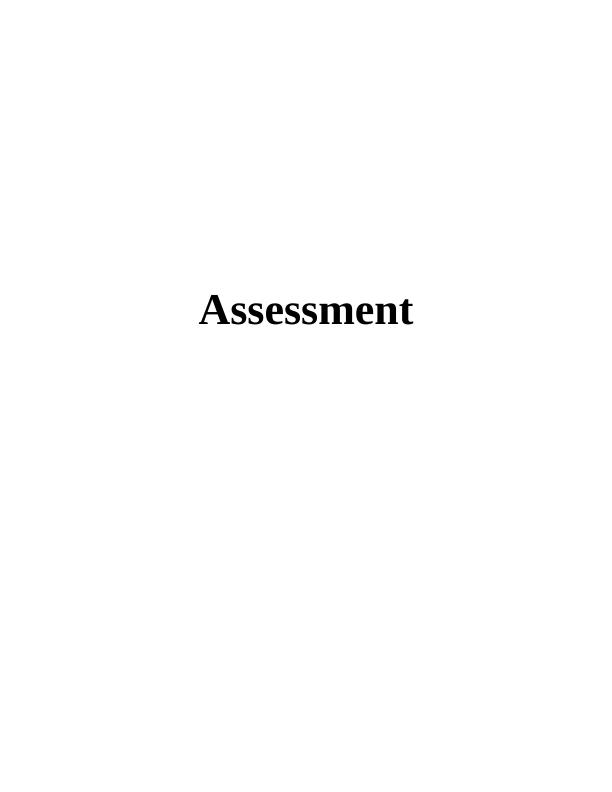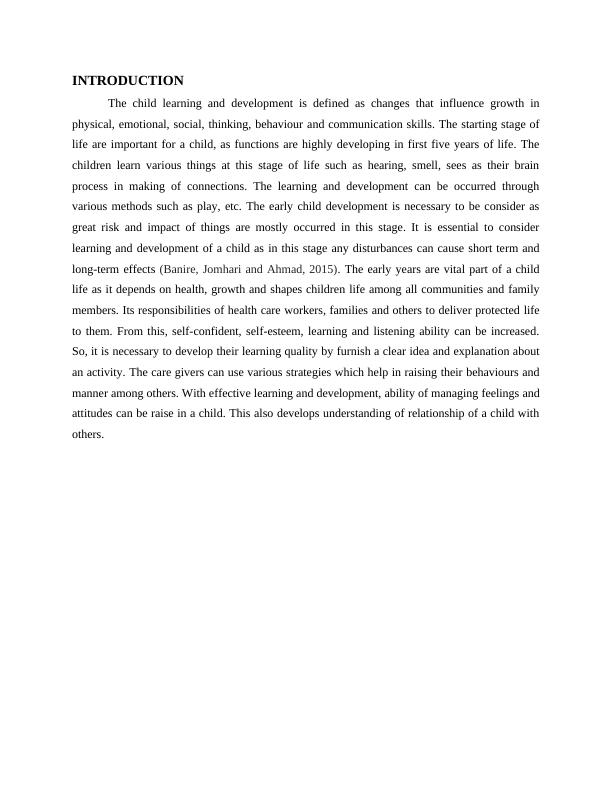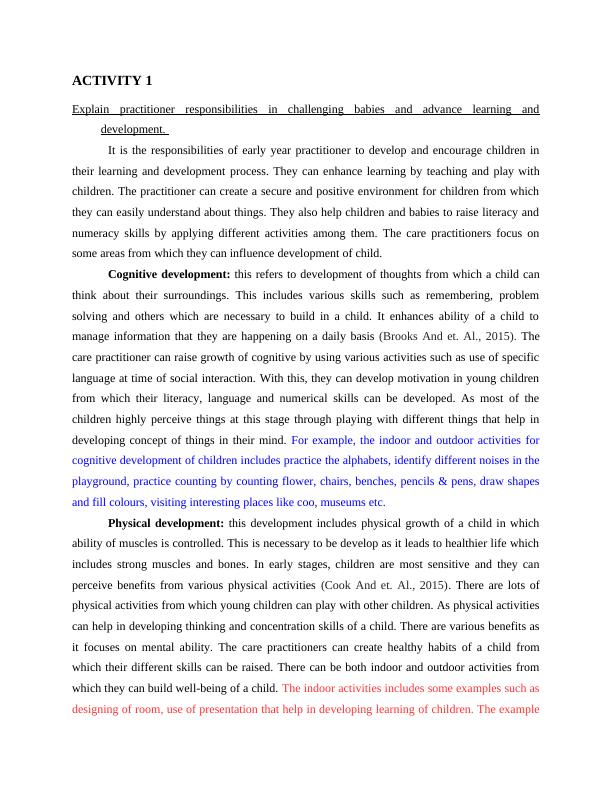Assessment
Added on 2023-01-13
19 Pages4976 Words66 Views
Assessment

Table of Contents
INTRODUCTION...........................................................................................................................2
ACTIVITY 1 ...................................................................................................................................3
Explain practitioner responsibilities in challenging babies and advance learning and
development. .........................................................................................................................3
ACTIVITY 2....................................................................................................................................5
Evaluate responsibilities of practitioner in relation to their role with staff............................5
ACTIVITY 3....................................................................................................................................6
Analyse requirements of framework in relation to developing own practices.......................6
ACTIVITY 5....................................................................................................................................7
Evaluation of partnership work between practitioners, parents and carers to enable babies to
learn and develop....................................................................................................................7
ACTIVITY 6 ...................................................................................................................................9
Evaluate the four safeguarding and child protection cases....................................................9
ACTIVITY 7....................................................................................................................................9
Explain pedagogical approaches and how they influence practices. .....................................9
ACTIVITY 8..................................................................................................................................13
Evaluate comparison and similarities between these two approaches.................................13
ACTIVITY 9..................................................................................................................................14
Demonstrate knowledge and knowledge of assessment in early years................................14
ACTIVITY 10................................................................................................................................15
Reflect on learning setting on your own practices...............................................................15
CONCLUSION..............................................................................................................................16
REFERENCES..............................................................................................................................17
INTRODUCTION...........................................................................................................................2
ACTIVITY 1 ...................................................................................................................................3
Explain practitioner responsibilities in challenging babies and advance learning and
development. .........................................................................................................................3
ACTIVITY 2....................................................................................................................................5
Evaluate responsibilities of practitioner in relation to their role with staff............................5
ACTIVITY 3....................................................................................................................................6
Analyse requirements of framework in relation to developing own practices.......................6
ACTIVITY 5....................................................................................................................................7
Evaluation of partnership work between practitioners, parents and carers to enable babies to
learn and develop....................................................................................................................7
ACTIVITY 6 ...................................................................................................................................9
Evaluate the four safeguarding and child protection cases....................................................9
ACTIVITY 7....................................................................................................................................9
Explain pedagogical approaches and how they influence practices. .....................................9
ACTIVITY 8..................................................................................................................................13
Evaluate comparison and similarities between these two approaches.................................13
ACTIVITY 9..................................................................................................................................14
Demonstrate knowledge and knowledge of assessment in early years................................14
ACTIVITY 10................................................................................................................................15
Reflect on learning setting on your own practices...............................................................15
CONCLUSION..............................................................................................................................16
REFERENCES..............................................................................................................................17

INTRODUCTION
The child learning and development is defined as changes that influence growth in
physical, emotional, social, thinking, behaviour and communication skills. The starting stage of
life are important for a child, as functions are highly developing in first five years of life. The
children learn various things at this stage of life such as hearing, smell, sees as their brain
process in making of connections. The learning and development can be occurred through
various methods such as play, etc. The early child development is necessary to be consider as
great risk and impact of things are mostly occurred in this stage. It is essential to consider
learning and development of a child as in this stage any disturbances can cause short term and
long-term effects (Banire, Jomhari and Ahmad, 2015). The early years are vital part of a child
life as it depends on health, growth and shapes children life among all communities and family
members. Its responsibilities of health care workers, families and others to deliver protected life
to them. From this, self-confident, self-esteem, learning and listening ability can be increased.
So, it is necessary to develop their learning quality by furnish a clear idea and explanation about
an activity. The care givers can use various strategies which help in raising their behaviours and
manner among others. With effective learning and development, ability of managing feelings and
attitudes can be raise in a child. This also develops understanding of relationship of a child with
others.
The child learning and development is defined as changes that influence growth in
physical, emotional, social, thinking, behaviour and communication skills. The starting stage of
life are important for a child, as functions are highly developing in first five years of life. The
children learn various things at this stage of life such as hearing, smell, sees as their brain
process in making of connections. The learning and development can be occurred through
various methods such as play, etc. The early child development is necessary to be consider as
great risk and impact of things are mostly occurred in this stage. It is essential to consider
learning and development of a child as in this stage any disturbances can cause short term and
long-term effects (Banire, Jomhari and Ahmad, 2015). The early years are vital part of a child
life as it depends on health, growth and shapes children life among all communities and family
members. Its responsibilities of health care workers, families and others to deliver protected life
to them. From this, self-confident, self-esteem, learning and listening ability can be increased.
So, it is necessary to develop their learning quality by furnish a clear idea and explanation about
an activity. The care givers can use various strategies which help in raising their behaviours and
manner among others. With effective learning and development, ability of managing feelings and
attitudes can be raise in a child. This also develops understanding of relationship of a child with
others.

ACTIVITY 1
Explain practitioner responsibilities in challenging babies and advance learning and
development.
It is the responsibilities of early year practitioner to develop and encourage children in
their learning and development process. They can enhance learning by teaching and play with
children. The practitioner can create a secure and positive environment for children from which
they can easily understand about things. They also help children and babies to raise literacy and
numeracy skills by applying different activities among them. The care practitioners focus on
some areas from which they can influence development of child.
Cognitive development: this refers to development of thoughts from which a child can
think about their surroundings. This includes various skills such as remembering, problem
solving and others which are necessary to build in a child. It enhances ability of a child to
manage information that they are happening on a daily basis (Brooks And et. Al., 2015). The
care practitioner can raise growth of cognitive by using various activities such as use of specific
language at time of social interaction. With this, they can develop motivation in young children
from which their literacy, language and numerical skills can be developed. As most of the
children highly perceive things at this stage through playing with different things that help in
developing concept of things in their mind. For example, the indoor and outdoor activities for
cognitive development of children includes practice the alphabets, identify different noises in the
playground, practice counting by counting flower, chairs, benches, pencils & pens, draw shapes
and fill colours, visiting interesting places like coo, museums etc.
Physical development: this development includes physical growth of a child in which
ability of muscles is controlled. This is necessary to be develop as it leads to healthier life which
includes strong muscles and bones. In early stages, children are most sensitive and they can
perceive benefits from various physical activities (Cook And et. Al., 2015). There are lots of
physical activities from which young children can play with other children. As physical activities
can help in developing thinking and concentration skills of a child. There are various benefits as
it focuses on mental ability. The care practitioners can create healthy habits of a child from
which their different skills can be raised. There can be both indoor and outdoor activities from
which they can build well-being of a child. The indoor activities includes some examples such as
designing of room, use of presentation that help in developing learning of children. The example
Explain practitioner responsibilities in challenging babies and advance learning and
development.
It is the responsibilities of early year practitioner to develop and encourage children in
their learning and development process. They can enhance learning by teaching and play with
children. The practitioner can create a secure and positive environment for children from which
they can easily understand about things. They also help children and babies to raise literacy and
numeracy skills by applying different activities among them. The care practitioners focus on
some areas from which they can influence development of child.
Cognitive development: this refers to development of thoughts from which a child can
think about their surroundings. This includes various skills such as remembering, problem
solving and others which are necessary to build in a child. It enhances ability of a child to
manage information that they are happening on a daily basis (Brooks And et. Al., 2015). The
care practitioner can raise growth of cognitive by using various activities such as use of specific
language at time of social interaction. With this, they can develop motivation in young children
from which their literacy, language and numerical skills can be developed. As most of the
children highly perceive things at this stage through playing with different things that help in
developing concept of things in their mind. For example, the indoor and outdoor activities for
cognitive development of children includes practice the alphabets, identify different noises in the
playground, practice counting by counting flower, chairs, benches, pencils & pens, draw shapes
and fill colours, visiting interesting places like coo, museums etc.
Physical development: this development includes physical growth of a child in which
ability of muscles is controlled. This is necessary to be develop as it leads to healthier life which
includes strong muscles and bones. In early stages, children are most sensitive and they can
perceive benefits from various physical activities (Cook And et. Al., 2015). There are lots of
physical activities from which young children can play with other children. As physical activities
can help in developing thinking and concentration skills of a child. There are various benefits as
it focuses on mental ability. The care practitioners can create healthy habits of a child from
which their different skills can be raised. There can be both indoor and outdoor activities from
which they can build well-being of a child. The indoor activities includes some examples such as
designing of room, use of presentation that help in developing learning of children. The example

End of preview
Want to access all the pages? Upload your documents or become a member.
Related Documents
Early Childhood Education and Carelg...
|13
|2628
|254
early learning and practice frameworkslg...
|21
|4410
|71
Development Stages of Childhoodlg...
|10
|2542
|465
Role of Early Years Practitioner in Child Developmentlg...
|8
|2586
|2
Leading Practice with Children, Families and Professionalslg...
|5
|1866
|228
Impact of Social, Environmental and Cultural Factors on Baby Developmentlg...
|11
|4519
|22